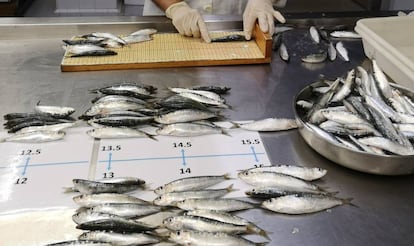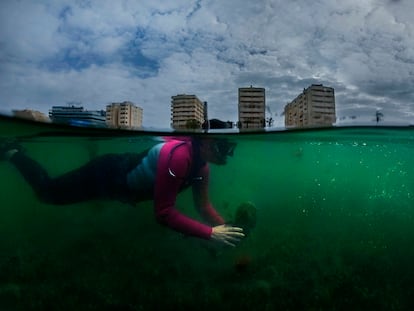Microplastics and parasites: A look inside the fish of the Western Mediterranean
Study finds a correlation between the presence of small synthetic fibers and the prevalence of worms in the guts of sardines and anchovies, two of the most commercialized species

It all began when the team led by Marta Coll, a researcher at the Barcelona Marine Sciences Institute, which is part of the Spanish National Research Council (ICM-CSIC), was searching for the causes of the decline in sardine and anchovy populations. These are the two most commercialized fish species in the northwestern Mediterranean, representing up to 39% of total catches in the region in recent years.
The two main culprits had already been well documented, notes Coll: overfishing and climate change. But researchers found a third, unexpected reason for the depleted populations of Sardina pilchardus and Engraulis encrasicolus: microplastics, plastic particles and fibers less than 5 millimeters in size, which they detected inside the animals’ intestinal tracts.
A recent study published in the journal Marine Pollution Bulletin concluded that 58% of sardines and 60% of anchovies have ingested microplastics. “The next stage is understanding what kind of an impact this will have on people who eat these fish,” says Coll, who co-authored the study.
Researchers found that fish with microplastics in their digestive system also had parasites such as larvae, trematodes and nematodes (a type of worm) and generally had a worse overall body condition. “This is the first time that we prove such a clear correlation between parasites and microplastics in fish,” says Coll.
This is the first time that we prove such a clear correlation between parasites and microplastics in fishMarta Coll, researcher at ICM-CSIC
There are still unconfirmed theories about the mechanism by which fish with more microplastics also have more parasites. “We don’t know clearly. But what is clear is that the greater the presence of microplastics, the worse condition the fish are in, and they also have parasites,” says the researcher.
One theory is that the parasites could already be on the plastic at the time that the fish swallows the latter. Another possibility revolves around the river areas where waste is discharged, which makes the water dirtier and attracts more parasites.
“The next stages of our work involve understanding this correlation and seeing how it affects the fish: whether more individuals die, whether the muscles are affected, whether this is the reason why they are thinner,” says Coll.
One of the scientific community’s great concerns is what kind of an impact the presence of intestinal microplastics may have on the food chain. “It [the food chain] is deteriorated, and that has a great impact. These fish are the main food source for many organisms, whether commercially fished or not. Whatever happens to them will also happen to all the species that feed on them,” notes Coll.
Cristina Romera, an expert on the consequences of plastics degradation who works at ICM-CSIC, says she was surprised at the correlation between parasites and microplastics.
“It opens up the door to new research to understand the impact on fish and on human beings, especially since these are two of the most commercialized fish species,” she says.
Romera notes that even if the fish are gutted before consumption, there is still a possibility that some of the plastic may have settled in other tissues that people do eat. “It would be interesting, and important, to know if this is happening, just like knowing whether the microplastics have absorbed toxic components during their ocean journey.”
The study underscores that sardines are more likely to ingest microplastics in the Gulf of Alicante, while for anchovies the most favorable area for plastic ingestion is the Gulf of Lion – Ebro River Delta.
Scientists have known for some time about the presence of microplastics in fish. In a recent article published in Environmental Pollution, Spanish researchers noted that over 65% of deep-sea shrimp on the Catalan coast have synthetic fibers in their stomachs and intestinal tracts. As for anchovies, it was proven last year that 83.3% of analyzed individuals had ingested microplastics in the eastern Mediterranean, while an earlier study found 90% of analyzed anchovies in the Adriatic Sea had plastics in their stomachs.
A hard chain to break
Humans dump up to 13 million tons of plastic into the ocean every year, killing around 100,000 marine species, according to the United Nations. To this staggering amount of litter must be added microplastics, so tiny that they are impossible to eliminate, at least for now.
The production and use of microplastics has been increasing since 1950, when it reached over 300 million tons globally in 2017, as noted in Coll’s study, in which the Spanish Oceanographic Institute (IEO) and the French marine research institute IFREMER also took part.
Coll says that while there is no easy solution, “it is obvious that we need to reduce single-use plastics; to make sure that the plastic we do consume is truly essential; and that when we discard it, it will be properly managed so it doesn’t end up in the ocean.”
By the time plastic reaches the oceans, things get much more difficult, agrees Romera. “What’s already in the sea is out of control,” she says. “We have only counted 1% of the plastic out there, 99% is lost at the bottom of the sea, in the water columns or inside organisms,” she says. The most feasible solution, at least for now, is to introduce measures to prevent the plastic from reaching the ocean in the first place.
English version by Susana Urra.
Tu suscripción se está usando en otro dispositivo
¿Quieres añadir otro usuario a tu suscripción?
Si continúas leyendo en este dispositivo, no se podrá leer en el otro.
FlechaTu suscripción se está usando en otro dispositivo y solo puedes acceder a EL PAÍS desde un dispositivo a la vez.
Si quieres compartir tu cuenta, cambia tu suscripción a la modalidad Premium, así podrás añadir otro usuario. Cada uno accederá con su propia cuenta de email, lo que os permitirá personalizar vuestra experiencia en EL PAÍS.
¿Tienes una suscripción de empresa? Accede aquí para contratar más cuentas.
En el caso de no saber quién está usando tu cuenta, te recomendamos cambiar tu contraseña aquí.
Si decides continuar compartiendo tu cuenta, este mensaje se mostrará en tu dispositivo y en el de la otra persona que está usando tu cuenta de forma indefinida, afectando a tu experiencia de lectura. Puedes consultar aquí los términos y condiciones de la suscripción digital.
More information
Últimas noticias
Most viewed
- Sinaloa Cartel war is taking its toll on Los Chapitos
- Oona Chaplin: ‘I told James Cameron that I was living in a treehouse and starting a permaculture project with a friend’
- Reinhard Genzel, Nobel laureate in physics: ‘One-minute videos will never give you the truth’
- Why the price of coffee has skyrocketed: from Brazilian plantations to specialty coffee houses
- Silver prices are going crazy: This is what’s fueling the rally









































